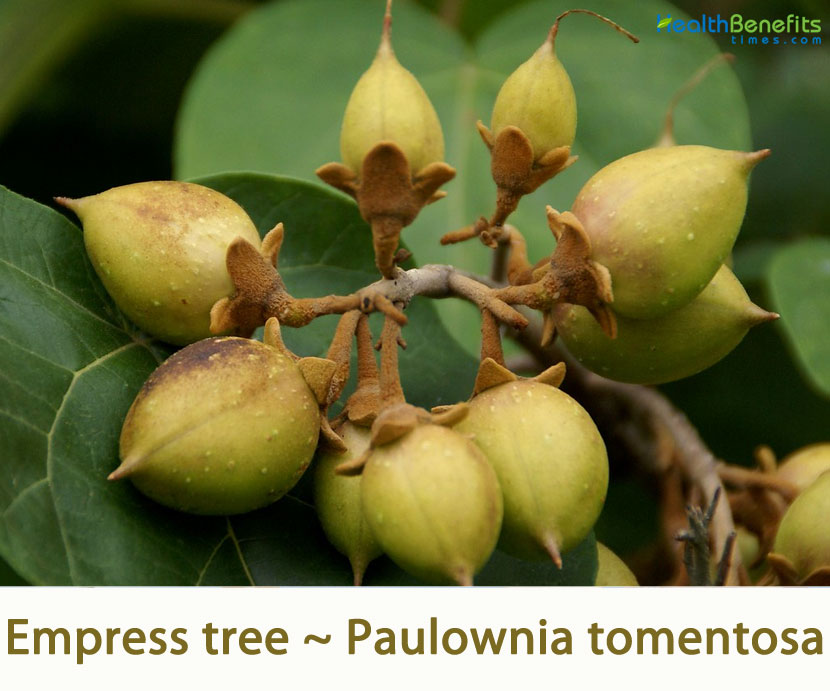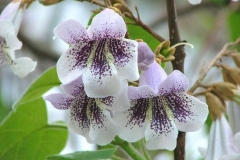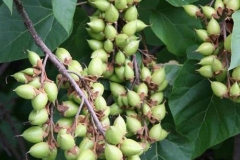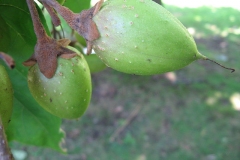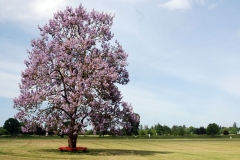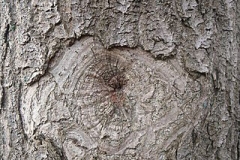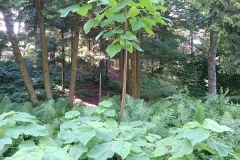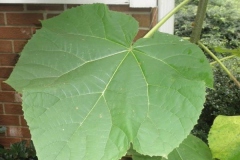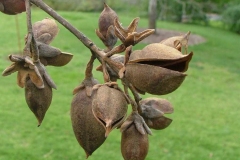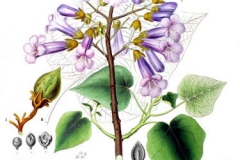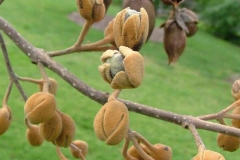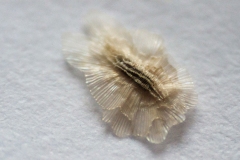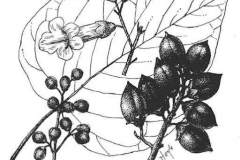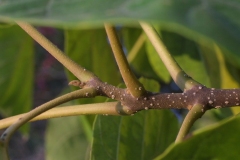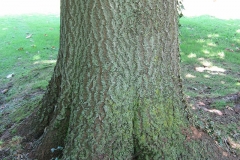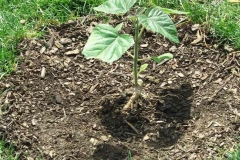Apart from Empress tree it is also known as Chinese empress tree, foxglove tree, karri tree, karritree, princess tree, princess-tree, royal paulownia, butterfly tree, empress of China, paulownia, paulownia tree and royal paulownia tree. The generic name Paulownia honors Princess Anna Paulowna (1795-1865), daughter of Czar Paul I of Russia. The specific epithet tomentosa is a Latin word meaning covered in hairs. The tree is harvested from the wild for local use as a medicine, source of materials and sometimes as a food. It is a showy, aggressive ornamental tree that is also grown in plantations for timber production. It has tended to escape from cultivation and invade disturbed areas. It can invade rapidly after disturbances such as fire, construction or floods, and its ability to resprout prolifically allows it to survive fire, cutting, and even bulldozing on building sites.
Empress Tree Facts
| Empress tree Quick Facts | |
|---|---|
| Name: | Empress tree |
| Scientific Name: | Paulownia tomentosa |
| Origin | China, and is widely distributed in central and northern regions, especially Shaanxi, Shanxi, Gansu, Henan, Hebei, Shandong, Anhui, Hubei, Jiangsu, and the Liaoning peninsula |
| Colors | Initially sticky and green, later turning brown and dry, persistent |
| Shapes | Woody, beaked, egg-shaped capsules that are 1-2 inches. (2.5-5.1 cm) long and 1-1.5 in. (2.5-3.8 cm) wide, borne in terminal clusters |
| Health benefits | Good for hemorrhoid, carbuncle, inflammatory bronchitis, gonorrhea, upper respiratory tract infection, parotitis, asthma, traumatic bleeding, erysipelas, bacteriological diarrhea, swelling, bronchopneumonia, enteritis, conjunctivitis, hypertension and tonsillitis |
| Name | Empress tree |
|---|---|
| Scientific Name | Paulownia tomentosa |
| Native | China, and is widely distributed in central and northern regions, especially Shaanxi, Shanxi, Gansu, Henan, Hebei, Shandong, Anhui, Hubei, Jiangsu, and the Liaoning peninsula. It also occurs in Japan and South Korea |
| Common Names | Chinese empress tree, empress tree, empress-tree, foxglove tree, karri tree, karritree, princess tree, princess-tree, royal paulownia, butterfly tree, empress of China, paulownia, paulownia tree, royal royal paulownia tree |
| Name in Other Languages | Arabic: bulfiniat kathat alzughab (بولفينية كثة الزغب), bulfiniat kuria (بولفينية كورية) Armenian: Pavlovnia t’aghik’anman (Պավլովնիա թաղիքանման) Azerbaijani: Adəm ağacı Brazil: Paulovnia-real, quirí Bulgarian: Plŭtnovlyak nesta paulovniya (плътновлякнеста павловния) Catalan: Paulònia Chinese: Mao pao tong (毛泡桐), ribenpaotong, rongmaopaotong; zihuapaotong (紫花泡桐), zitong Croatian: Paulovnija, pustenasta paulovnija Czech: Paulovnie plstnatá, Pavlovnie plstnatá Danish: Kejsertræ Dutch: Anna Paulowna boom, Anna Pavlovna boom, Ijzerhout, Keizersboom, Koninginneboom English: Empress tree, Foxglove tree, Imperial paulownia, Karri tree, Princess tree, Royal paulownia, Karritree, Chinese empress tree Esperanto: Ĉina paŭlovnio Finnish: Keisaripuu French: Paulownia d’Anna Pavlovna, Paulownia imperial, Paulownia, arbré d’anna paulownia, paulownia tomenteux German: Blauglockenbaum, Chinesischer Blauglockenbaum, Kaiserbaum, Kiribaum, Kiri-Baum, Kaiser-Paulownie, Paulownie, Filziger Blauglockenbaum Greek: Paouló̱vnia i̱ af̱tokratorikí̱ (Παουλώβνια η αυτοκρατορική), Paoulóvnia af̱tokratorikí̱ (Παουλόβνια αυτοκρατορική), Pav̱ló̱nia (Παυλώνια) Hebrew: פולובניה הדורה Hungarian: Illatos császárfa, császárfa Italian: Pawlonia, paulovia Japanese: Kiri (キリ), Kiri (桐), Yori (より) Korean: Cham o dong na mu (참오동나무), odongnamu (오동나무) Lithuanian: Kininė paulovnija Netherland: Anna-paulownaboom Norwegian: Keisertre Persian: پالونیا Polish: Paulownia cesarska, Paulownia omszona Portuguese: Paulovnia-real, Quiri, Paulónia, árvore-da-princesa, kiri japonês Russian: Pavlovniia vojlochnaia (Павловния войлочная), adamovo derevo (адамово дерево), pavlovniya imperatorskaya (павловния императорская) Serbian: Paulovniǰa (Пауловнија), kinesko drvo (кинеско дрво) Slovak: Paulovnia plstnatá Spanish: Paulownia, paulownia imperial Swedish: Kejsarträd Ukrainian: Pavlovniya pukhnasta (павловнія пухната) Upper Sorbian: Kejžorska pawlownija Welsh: Coeden Bysedd y Cŵn |
| Plant Growth Habit | Showy, fast-growing, aggressive, large deciduous ornamental tree with an umbrella-shaped crown |
| Growing Climates | Deciduous, mixed forests, roadsides, clearings, forest margins, cliffs, steep rocky slopes, riverbanks and disturbed habitats including fire sites and forests defoliated by pests |
| Soil | Prefer moist, freely drained sands, loams or clays on steep slopes or open valleys, and only rarely on saline and alkaline soils. However, fertile farmland is essential for high-production plantations. It tolerates high soil acidity, drought, and low soil fertility, but prefers full sunlight, ample soil moisture and fertile soil |
| Plant Size | 50-60 ft. (15.2-18.3 m) tall with a diameter of at least 2 ft. (0.6 m) |
| Root | Roots can be relatively shallow to deep and well developed, apparently depending upon soil conditions. They are typically widely spreading without a strong taproot |
| Twigs | Olive brown to dark brown twigs are stout and brittle, mostly glabrous except at the tip, around buds and along upper edges of leaf scars, lenticels pale, prominent, and elongated longitudinally |
| Bark | Bark is smooth and pale yellow to brown with numerous large lenticels when young, becoming rough and grey-brown with age, often with interlaced smooth areas that are often shiny |
| Leaf | Large, deciduous leaves are opposite and broadly ovate, acuminate and cordate in shape. Leaf margins are entire or shallowly lobed, and may be toothed on small plants. Leaves of adult trees are 15-40 cm (6-16 in) long and 10-30 cm (4-8 in) wide, though leaves of stump sprouts may be twice as large. They are arranged opposite along the stem, hairy on both surfaces. |
| Flowering season | May-June |
| Flower | Large, showy, fragrant blossoms are borne in upright clusters 15-30 cm (6- 12 in) long at the ends of stout, hairy twigs. Corolla is 5 cm (2 in) long, bell-shaped, and pale violet with yellow stripes inside, ending with five round, unequal lobes |
| Fruit Shape & Size | Woody, beaked, egg-shaped capsules that are 1-2 inches. (2.5-5.1 cm) long and 1-1.5 in. (2.5-3.8 cm) wide, borne in terminal clusters |
| Fruit Color | Initially sticky and green, later turning brown and dry, persistent |
| Seed | Seeds are tiny, winged, flat, 1.5 mm long |
| Lifespan | More than 70 years |
| Propagation | By seed and sprouting |
| Plant Parts Used | Leaves, flowers, fruits, wood, bark, roots and seeds |
| Season | September to October |
| Culinary Uses |
|
| Precautions |
|
Plant Description
Empress tree is a showy, fast-growing, aggressive, large deciduous ornamental tree that normally grows about 50-60 ft. (15.2-18.3 m) tall with a diameter of at least 2 ft. (0.6 m) with an umbrella-shaped crown and spreading branches. Young shoots can grow as much as 8–10 feet in a single year. Roots can be relatively shallow to deep and well developed, apparently depending upon soil conditions. They are typically widely spreading without a strong taproot. Olive brown to dark brown twigs are stout and brittle, markedly flattened at nodes, mostly glabrous except at the tip, around buds and along upper edges of leaf scars. Lenticels are pale, prominent, and elongated longitudinally. Pith can be chambered or hollow. Terminal leaf buds are absent. Lateral leaf buds are superimposed. Leaf scars are circular. Bark is smooth and pale yellow to brown with numerous large lenticels when young, becoming rough and grey-brown with age, often with interlaced smooth areas that are often shiny. The smooth brown bark of young branches has prominent white lenticels.
Plant is found growing in deciduous, mixed forests, roadsides, clearings, forest margins, cliffs, steep rocky slopes, riverbanks and disturbed habitats including fire sites and forests defoliated by pests. The plant prefer moist, freely drained sands, loams or clays on steep slopes or open valleys, and only rarely on saline and alkaline soils. However, fertile farmland is essential for high-production plantations. It tolerates high soil acidity, drought, and low soil fertility, but prefers full sunlight, ample soil moisture and fertile soil.
Leaves
Large, deciduous leaves are opposite and broadly ovate, acuminate and cordate in shape. Leaf margins are entire or shallowly lobed, and may be toothed on small plants. Leaves of adult trees are 15-40 cm (6-16 in) long and 10-30 cm (4-8 in) wide, though leaves of stump sprouts may be twice as large. They are arranged opposite along the stem, hairy on both surfaces. Surfaces are pubescent and dull, light-green above, and pale-green and tomentose beneath. Petioles are also hairy and can be sticky when young. Leaves growing off root sprouts have been measured up to 2 ft. (0.6 m) in length. Twigs are stout, brown, and speckled with white dots (lenticels). They can be slightly hairy when young. Lateral leaf scars are somewhat round, becoming darker and sunken. The pith is chambered or sometimes hollow.
| Leaf arrangement | Opposite/subopposite |
| Leaf type | Simple |
| Leaf margin | Entire |
| Leaf shape | Ovate, cordate |
| Leaf venation | Palmate, pinnate |
| Leaf type and persistence | Deciduous |
| Leaf blade length | 4 to 8 inches, 8 to 12 inches |
| Leaf color | Green |
| Fall color | No color change |
| Fall characteristic | Not showy |
Flowers
Large, showy, fragrant blossoms are borne in upright clusters 15-30 cm (6- 12 in) long at the ends of stout, hairy twigs. Corolla is 5 cm (2 in) long, bell-shaped, and pale violet with yellow stripes inside, ending with five round, unequal lobes. Blooms in April-May before the leaves emerge from round, brown, hairy buds formed during the previous summer. Flower buds are hairy and linear, becoming round.
| Flower color | Lavender |
| Flower characteristics | Very showy |
Fruit
Fertile flowers are followed by woody, beaked, egg-shaped capsules that are 1-2 inches. (2.5-5.1 cm) long and 1-1.5 in. (2.5-3.8 cm) wide, borne in terminal clusters. Seed pods are divided into 4 inner compartments that contain as many as 2,000 tiny winged seeds. Fruits are light green in the summer, becoming dark brown in the winter, and persist in clusters on the tree until the following spring. The capsules split in half during late winter to release up to 2000 tiny winged, wind-borne seeds 0.08-0.12 in. (2-3 mm). One tree is capable of producing twenty million seeds that are easily transported in water or wind.
| Fruit shape | Oval |
| Fruit length | 1 to 3 inches |
| Fruit covering | Dry or hard |
| Fruit color | Brown |
| Fruit characteristics | Does not attract wildlife; showy; fruit/leaves a litter problem |
Origin and Distribution
Empress tree is native to western and central China where historical records describe its medicinal, ornamental, and timber uses as early as the third century B.C. It has been cultivated for centuries in Japan where it is valued in many traditions. It was imported to Europe in the 1830s by the Dutch East India Company and brought to North America a few years later. It has been naturalized in the eastern U.S. for more than 150 years and is also grown on the west coast. USDA hardiness zones 7-10 are most favorable.
Traditional uses and benefits of Empress Tree
- Decoction of the leaves is used to wash foul ulcers and is also said to promote the growth of hair and prevent greying.
- The leaves are also poultice onto bruises.
- The leaf juice is used in the treatment of warts.
- The flowers are used in the treatment of skin ailments.
- Tincture of the inner bark is used in the treatment of fevers and delirium.
- It is astringent and vermifuge.
- In traditional Chinese medicine for centuries it has been used to treat bronchitis, coughs, asthma and high blood pressure, and flowers, leaves and bark are effective in treating chronic tracheitis.
- In traditional Chinese medicine, the bark, fruit, xylem, and leaves have been applied to treat or prevent a variety of diseases, such as hemorrhoid, carbuncle, inflammatory bronchitis, gonorrhea, upper respiratory tract infection, hemorrhoids, parotitis, asthma, traumatic bleeding, erysipelas, bacteriological diarrhea, swelling, bronchopneumonia, enteritis, conjunctivitis, hypertension, and tonsillitis.
- Empress tree may also have wound-healing properties, as the leaves have been used for the treatment of frostbite and leg ulcers.
- Leaves, fruits, and flower are the most important plant parts used in folk herbal
- Folk remedies in China use mashed Empress Tree flowers to treat acne vulgaris and the decoction to treat fungal infection on the sole of the foot and the skin between toes.
- Flowers are also used in treatment of first to second-degree empyrosis.
Other Facts
- Wood is used for making boxes, clogs, furniture, musical instruments etc.
- It is good for posts and beams in construction.
- It is suitable for intercropping with wheat, oilseed rape and sweet potato, and in the sub-tropics it may be intercropped with tea and bamboo.
- It can also be used for windbreaks on farmlands, roadsides or canal-banks.
- It is also believed to reduce sulphur dioxide pollution and grows in environments where other trees may suffer leaf loss.
- Wood is used for oil drums, wine and beer barrels, tea boxes, fruit boxes, grain storage containers, traditional handicrafts, ornaments, agricultural tools, and especially beehives which maintain suitable temperatures resulting in increased honey production.
- It has been used for plywood and particleboard manufacture, and for kitchen utensils such as wooden bowls, plates and rice steamers.
- Flowers and leaves are traditionally used as fodder for pigs, goats and rabbits in Sichuan and Hebei.
- It is cultivated as an ornamental tree in parks and gardens.
- It has gained the Royal Horticultural Society’s Award of Garden Merit.
- The wood yields excellent charcoal used for high class fireworks and gunpowder.
- It is also used for beams and poles.
- The lightweight timber is highly valued in Taiwan and Japan, and suitable for wood work, musical instruments, sandals, delicate furniture, linings, cabinets, badminton rackets, and also for fishing net floats, boxes and crates.
- In China, it is planted for erosion control and intercropped with wheat.
- Wood and bark are reported to have astringent properties.
- Several species are used for reforestation in Thailand, and their use is being promoted in East Asia.
- The tree was introduced into the Philippines for wood producing plantations.
- It seems capable of cleaning air polluted with chlorine.
Management/Monitoring
Paulownia tomentosa can be controlled most effectively using an integrated management approach. Cutting or girdling trees with power or manual saws are effective at preventing seed production, but repeated cutting or an herbicide treatment is necessary following cutting since Paulownia readily resprouts.
Hand pulling
Young seedlings of Paulownia can be successfully controlled by manual removal. Pulling is easiest following a rain event, as the soil becomes loose. It is important to remove all root fragments as Paulownia can resprout from root fragments.
Cutting and Girdling
Cutting of Paulownia trees is most effective at the onset of flowering. Cutting at ground-level can prevent seed production for that year, but cutting alone must be repeated for several years to successfully kill the tree. Girdling results in top-kill of that stem, but may also induce increased resprouts. Cutting and girdling followed immediately by an herbicide application (cut-stump, hack-andsquirt) has good rates of efficacy.
Chemical Control
Paulownia can successfully be controlled by herbicides. The most common herbicides used to control Paulownia include glyphosate and triclopyr.
Foliar Spray
Paulownia seedlings can be controlled by using a foliar spray of either glyphosate (2% solution with 0.5% nonionic surfactant) or triclopyr (2% solution with 0.5% nonionic surfactant). These spray herbicides should be applied directly to the leaves and sprayed-to-wet.
Cut-Stump
Following cutting of the trees at ground-level, glyphosate (25% solution) or triclopyr (50% solution) should be directly applied to the stump. The cut-stump method can be used at all times of the year, as long as the ground is not frozen.
Girdling or Hack-and-Squirt
Immediately following girdling (approximately 15 cm above the ground and the cut should be well into or below the cambium layer) or hacking, directly apply glyphosate (25% solution) or triclopyr (50% solution) into the cut area.
Basal Bark
Apply a mixture of 25% triclopyr and 75% horticultural oil to the basal parts of the tree to a height of 30-38 cm (12-15 in) from the ground. Thorough wetting is necessary for good control, and spray until run-off is noticeable at the ground line. Basal bark applications should not be applied when the ground is frozen.
References:
https://www.itis.gov/servlet/SingleRpt/SingleRpt?search_topic=TSN&search_value=33460#null
http://www.hear.org/pier/species/paulownia_tomentosa.htm
https://pfaf.org/User/Plant.aspx?LatinName=Paulownia+tomentosa
https://www.cabi.org/isc/datasheet/39100
http://www.missouribotanicalgarden.org/PlantFinder/PlantFinderDetails.aspx?kempercode=a888
https://gd.eppo.int/taxon/PAZTO
http://www.theplantlist.org/tpl1.1/record/kew-2542391
https://keyserver.lucidcentral.org/weeds/data/media/Html/paulownia_tomentosa.htm
https://en.wikipedia.org/wiki/Paulownia_tomentosa
https://uses.plantnet-project.org/en/Paulownia_(PROSEA)
https://plants.usda.gov/home/plantProfile?symbol=PATO2
https://edis.ifas.ufl.edu/publication/ST433
https://dendro.cnre.vt.edu/dendrology/syllabus/factsheet.cfm?ID=145
http://temperate.theferns.info/plant/Paulownia+tomentosa
https://www.se-eppc.org/manual/princess.html
https://gobotany.nativeplanttrust.org/species/paulownia/tomentosa/
http://www.flowersofindia.net/catalog/slides/Empress%20Tree.html


